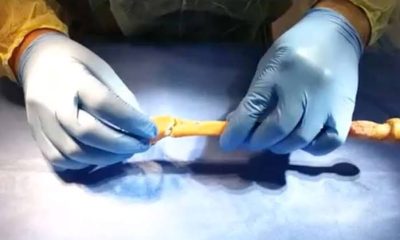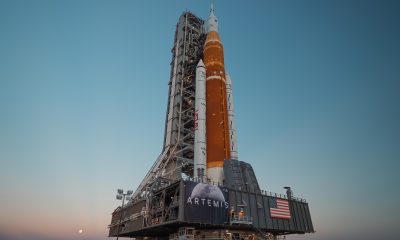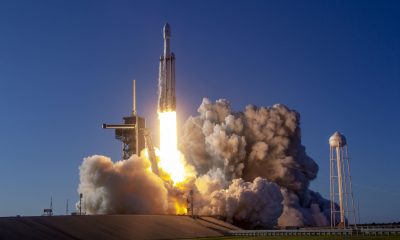Technology
James Webb Space Telescope; Launch date, mission and updates

The James Webb Space Telescope is a space telescope designed primarily to conduct infrared astronomy. The most powerful telescope ever launched into space, its greatly improved infrared resolution and sensitivity will allow it to view objects too old, distant, or faint for the Hubble Space Telescope.
Accessible to the worldwide scientific community, it will offer scientists the opportunity to observe galaxy evolution, the formation of stars and planets, exoplanetary systems, and our own solar system, in ways never before possible.

James Web Space Telescope in assembly
The James Webb Space telescope is getting launched from Europe Space center in Kourou, French Guiana. It scheduled for 24th December 2021 on an Ariane 5 rocket during Ariane flight VA256 specially adopted for the mission. The James Webb Space Telescope (JWST) is a space telescope being jointly developed by NASA, the European Space Agency (ESA), and the Canadian Space Agency (CSA). It is planned to succeed the Hubble Space Telescope as NASA’s flagship astrophysics mission.

Webb and Ariane 5
Why is NASA’s most expensive scientific instrument ever launching on a European rocket? This is because the European Space Agency ESA would share observation time using the infrared telescope, and so conducting the launch for NASA in contribution for it. James Webb Space Telescope will observe wavelengths of light longer than those of the Hubble Space telescope, and this should allow the new instrument to see the earliest galaxies of the Universe.
It will provide improved infrared resolution and sensitivity over Hubble, and will enable a broad range of investigations across the fields of astronomy and cosmology, including observing some of the most distant events and objects in the universe, such as the formation of the first galaxies, and detailed atmospheric characterization of Earth-like or potentially habitable exoplanets.
Comparison of the James Webb Space telescope and Hubble Space Telescope
The space telescope everyone is most familiar with is Hubble, launched in 1990. Hubble is able to show the age of the universe, the black holes at the core of nearly every galaxy, and a 3D map of dark matter, with its 7.8-foot primary mirror and cameras, spectrographs, and interferometers. JWST expands humanity’s view by looking at the infrared slice of the light spectrum.
Hubble mainly operates in the visible light spectrum and ultraviolet; while JWST is built for infrared light, which has longer wavelengths. (Here’s a primer on the electromagnetic spectrum.) With its longer wavelengths, infrared light is better at slipping through dusty clouds unimpeded, meaning JWST will be able to see celestial objects hidden from Hubble’s eye. Infrared is also where you can observe the oldest galaxies in the universe. As the universe expands, wavelengths of light itself are stretched. What was once emitted as visible or ultraviolet light is now infrared.
The James Webb Space telescope JWST will allow astronomers to see the very first galaxies, formed 13 billion years ago. It will also be able to probe the atmospheres of exoplanets, determining how habitable their compositions might be and peer through murky nebulae to watch stars being born. But in order to do that, JWST needs a massive mirror, 21 feet across compared with Hubble’s not quite 8. (Spitzer, NASA’s current infrared-sensing space telescope, has a mirror of a measly 2.7 feet.) Not to mention that JWST’s mirror needs to operate at cryogenically cold temperatures, since anything warmer emits infrared radiation that can obscure the delicate signals it’s sensing.
While Hubble orbits the Earth about 340 miles up, JWST won’t orbit Earth at all but will live at a point in space known as L2, one of the Earth-sun Lagrange points. Lagrange points are gravitationally stable spots where the pull from the Earth and sun balance out a satellite’s orbital motion. L2 is 930,000 miles past Earth, in the opposite direction from the sun. Technically, JWST will be in orbit around L2, always facing the Earth and sun in one direction, for solar power and communications. This means JWST can point its cold mirrors in the opposite direction, protected by a massive sunshield, toward the depths of space.
Development
NASA’s Goddard Space Flight Center in Greenbelt, Maryland, is leading the management of the observatory project. The project scientist for the James Webb Space Telescope is John C. Mather. Northrop Grumman Aerospace Systems serves as the primary contractor for the development and integration of the observatory. They are responsible for developing and building the spacecraft element, which includes both the spacecraft bus and sunshield. Ball Aerospace & Technologies has been subcontracted to develop and build the Optical Telescope Element (OTE). Northrop Grumman’s Astro Aerospace business unit has been contracted to build the Deployable Tower Assembly (DTA) which connects the OTE to the spacecraft bus and the Mid Boom Assembly (MBA) which helps to deploy the large sunshields on orbit. Goddard Space Flight Center is also responsible for providing the Integrated Science Instrument Module (ISIM).

JWST annotated diagram showing components
Partnership
NASA, ESA and CSA have collaborated on the telescope since 1996. ESA’s participation in construction and launch was approved by its members in 2003 and an agreement was signed between ESA and NASA in 2007. In exchange for full partnership, representation and access to the observatory for its astronomers, ESA is providing the NIRSpec instrument, the Optical Bench Assembly of the MIRI instrument, an Ariane 5 ECA launcher, and manpower to support operations. The CSA will provide the Fine Guidance Sensor and the Near-Infrared Imager Slitless Spectrograph plus manpower to support operations.
Several thousand scientists, engineers, and technicians spanning 15 countries have contributed to JWST. A total of 258 companies, government agencies, and academic institutions are participating in the project; 142 from the United States, 104 from 12 European countries and 12 from Canada.
Mission
The James Webb Space Telescope has four key goals:
- Search for light from the first stars and galaxies that formed in the Universe after the Big Bang
- To study the formation and evolution of galaxies
- Establish understand the formation of stars and planetary systems
- To study planetary systems and the origins of life.
These goals can be accomplished more effectively by observation in near-infrared light rather than light in the visible part of the spectrum. For this reason, JWST’s instruments will not measure visible or ultraviolet light like the Hubble Telescope, but will have a much greater capacity to perform infrared astronomy. JWST will be sensitive to a range of wavelengths from 0.6 (orange light) to 28 micrometres (deep infrared radiation at about 100 K (−173 °C; −280°F)).
After JWST is blasted into space on its rocket, once it has separated from the rocket and is flying free, it will spend 29 days unfolding and assembling itself on its way to L2. In the first day, the solar array and major antenna will be released so the telescope can receive energy and Earthly communications, and the first trajectory corrections will be made. By Day Three, Webb Telescope will be past the orbit of the moon. The girders holding the sunshield will extend, and the mirror and main machinery will move apart by several feet. The five layers of the sunshield will be extended, gossamer-thin and about as big as a tennis court. Then the side panels of the 18-pane mirror will swing into place. All along, small tweaks will be made to the telescope’s course, so that at the end of the first month, it will settle into orbit around L2.
That distant destination also means that the telescope will be on its own, no hope for a space-walk tuneup like the ones Hubble has been able to receive. There would be no easy means to servicing the telescope at its location near the Sun-Earth LaGrange point 1.5 million km from Earth or four times the distance to the moon. To the frustration of scientists and policymakers, numerous technical problems have delayed Webb’s development over the last decade, leading to enormous cost overruns. Some of this is understandable as rolling out the 20 meter long telescope in deep space requires 50 major deployments and 178 major release mechanisms. All of which must work or the instrument will fail.
Webb Telescope Updates
NASA’s James Webb Space Telescope, a partnership with ESA (European Space Agency) and the Canadian Space Agency (CSA), will release its first full-color images and spectroscopic data on July 12, 2022. As the largest and most complex observatory ever launched into space, Webb Telescope has been going through a six-month period of preparation before it can begin science work, calibrating its instruments to its space environment and aligning its mirrors.
This careful process, not to mention years of new technology development and mission planning, has built up to the first images and data: a demonstration of Webb at its full power, ready to begin its science mission and unfold the infrared universe.
The images will be released one-by-one during a televised broadcast beginning at 10:30 a.m. EDT on Tuesday, July 12, from NASA’s Goddard Space Flight Center in Greenbelt, Maryland. Live coverage of the image release broadcast will air on NASA TV, the NASA app, and the agency’s website. The public also can watch live on Facebook, Twitter, YouTube, Twitch, and Daily Motion.
Additionally, Webb telescope experts will answer questions about the first images and data in a NASA Science Live show on Wednesday, July 13, at 3 p.m. EDT. The broadcast, Webb’s First Full-Color Images Explained, will air live on the NASA Science Live website, as well as YouTube, Facebook, and Twitter. NASA will also broadcast a live social media event in Spanish on its NASA en español YouTube, Facebook, and Twitter accounts.
Webb, an international collaboration led by NASA with its partners the European Space Agency and the Canadian Space Agency, is the biggest telescope ever launched into space. It will unlock mysteries in our solar system, look beyond to distant worlds around other stars, and probe the mysterious structures and origins of our universe and our place in it.

-

 Brands2 years ago
Brands2 years agoRevBio Tetranite Regenerative Bone Adhesive Actions and Microgravity Technology.
-

 Brands2 years ago
Brands2 years agoBMW ix5 Hydrogen; Features, Release date, Price and specs.
-

 Brands2 years ago
Brands2 years agoBMW i7 All Electric Executive Sedan Features and Price
-

 Lifestyle2 years ago
Lifestyle2 years agoJeff Bezos; Networth, Career and lifestyle
-

 Brands2 years ago
Brands2 years agoSpace Launch System SLS; NASA’s Artemis Mega Rocket for Deep Space Exploration
-

 Brands2 years ago
Brands2 years agoDodge Charger Daytona SRT EV Concept; Electric muscle car specs, release date and price
-

 Brands2 years ago
Brands2 years agoHydrogen Fuel Cell Electric Vehicles FCEVs; Technology and features
-

 Brands2 years ago
Brands2 years agoHydrogen Fuel; Green Fuel of the future, types and production processes.


Pingback: Falcon Heavy to launch the Roman Space Telescope study dark energy and dark matter.